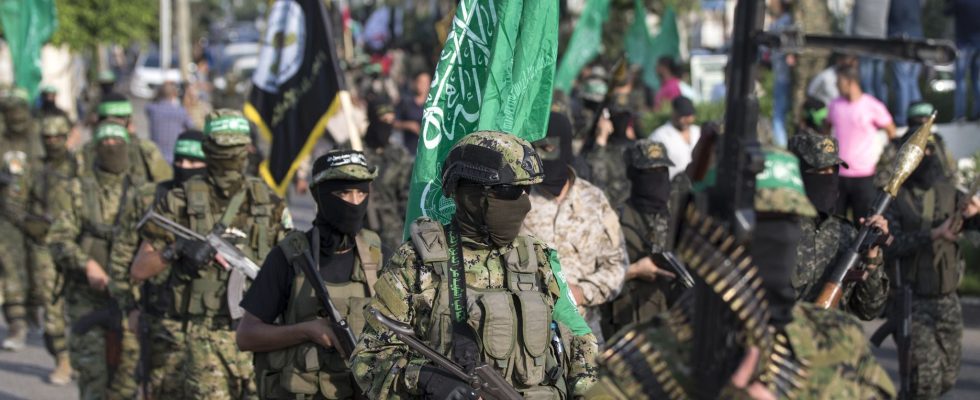An olive tree with a torn trunk lies on the dusty ground, among withered branches. Concealed behind this cache, two Hamas fighters emerged from the mouth of a tunnel, without attracting the attention of nearby Israeli troops. The first goes back and forth to a Merkava tank, located a few meters away, to deposit an explosive charge between the turret and the chassis. Then the second fires a rocket launcher at the vehicle, before returning underground with his companion. The editing of this propaganda video ends with the collection, later, of a piece of metal presented as a trophy.
Almost every day, the military branch of the Palestinian group, the Ezzedine al-Qassam brigades, behind the massacre of more than 1,400 Israelis on October 7, manages to broadcast images aimed at demonstrating its capabilities of retaliation against the Israeli forces. , among the most famous in the world. The IDF’s ground offensive on the Gaza Strip with the aim of destroying Hamas’ capabilities began on October 27 and is only just beginning. It promises to be long and expensive. Hamas’ control of the enclave with 2.3 million inhabitants has allowed it to build up a real army, trained and equipped.
“During the Israeli operation in Gaza in 2006, Summer Rain, Hamas fighters tended to refuse confrontation, which they no longer do, two years later, during Cast Lead, analysis war historian Michel Goya, former colonel of the marine troops. In 2014, for Protective Edge, not only did they not flee, but, what’s more, they fought effectively, organizing ambushes. Now, we notes a new qualitative leap, with an average of six Israeli soldiers killed per day, compared to three during the last operation.”
Zone defense for Hamas
Faced with the 20,000 infantrymen deployed by Israel in Gaza, the al-Qassam brigade would have up to 30,000 fighters – to which must be added several thousand men affiliated with other Palestinian groups such as Islamic Jihad, the Popular Liberation Front of Palestine and the Democratic Front for the Liberation of Palestine. “Three of the six Hamas brigades are in the north of Gaza and each is organized into autonomous battalions centered on a neighborhood, which their mission is to defend, through the action of small units which act according to the advance of the Israelis,” says military analyst Ron Ben-Yishay.
Against Israel’s firepower and its intelligence capabilities, Hamas fighters oppose their tunnels dug for twenty years in the layers of sand and clay of Gaza’s subsoil. They form a vast network of several hundred kilometers where “small teams of hunter-killers who move underground, emerge, strike and quickly return to a tunnel”, explains in a note John Spencer, researcher at the Institute of Modern Warfare at the US Military Academy West Point. “A large part of these tunnels are connected to civilian sites such as schools, hospitals and mosques,” adds this specialist in urban combat. Israeli forces released images showing a rocket launch site in a scout premises.
The Hamas underground complex also hides its stocks of weapons, some smuggled and others manufactured locally. “We have local factories for everything, for rockets with a range of 250, 160, 80, 10 kilometers, factories for mortars and their shells, factories for Kalashnikovs and their bullets,” he said. boasted a senior Hamas official, Ali Baraka, to the Russian media RT. In another video, Hamas members can be seen assembling in a cellar the shaped charges of anti-tank missiles from RPG-29 rocket launchers, its main weapon, with the RPG-7, against Israeli armor.
This know-how was passed on to them by the regime in place in Tehran and its Lebanese ally Hezbollah. “The Iranians explained how to produce these weapons themselves,” recalls Ron Ben-Yishay. Hamas also does recovery, collecting irrigation pipes from former settlements evacuated in 2005, metal debris left behind by airstrikes, but also charges of unexploded Israeli munitions. “The army indirectly provided Hamas with materials that are strictly monitored or prohibited in Gaza,” highlighted the Washington Institute in 2021.
Hamas knows its terrain perfectly
Added to this are the weapons introduced into Gaza, even if the closure of smuggling tunnels by Egypt on the border with Sinai has reduced the flow. Hamas thus used civilian drones equipped with explosive charges during the October 7 attack. It would also have more sophisticated weapons than its RPGs, but in fewer numbers, such as Russian Kornet anti-tank missiles and surface-to-air missiles like the Mutabar-1, recently put into service, to shoot down helicopters and drones.
But above all, Hamas knows its terrain perfectly. He did not seek to block the advances of the Israeli army in agricultural and suburban areas. In denser cities, the fighting could be much harder, especially since Palestinian fighters can take advantage of the rubble to attack opposing units, all in the midst of civilians – several thousand have been killed by airstrikes – and hostages. These urban clashes have only just begun. They promise to be the deadliest.
.
